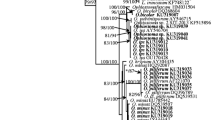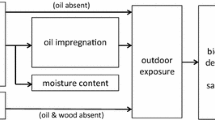Abstract
In this study the natural yeast populations on fruiting bodies of Pycnoporus sanguineus were characterized using restriction fragment length polymorphism (RFLP) analysis. The majority of the yeasts on these structures belonged to the ascomycetous species, Pichia guilliermondii while the rest were representatives of the basidiomycetous species Rhodotorula glutinis. The impact of these yeasts, as well as the pioneer fungus Aspergillus flavipes, on wood degradation by P. sanguineus was then determined by analyzing the major wood components after growth of co-cultures on Eucalyptus grandis wood chips. Standard protocols, commonly used by the paper and pulp industry, were employed to measure several parameters of the wood. Box plots were used for univariat descriptions of the data, while an analysis-of-distance (AOD) biplot revealed the multidimensional characteristics of the data. The results indicated that the yeasts had no effect on degradation of E. grandis wood chips by P. sanguineus, while the presence of A. flavipes impacted on the chemical composition of the residual wood chips.


Similar content being viewed by others
References
Bai F-Y, Zhao J-H, Takashima M, Jia J-H, Boekhout T, Nakase T (2002) Reclassification of the Sporobolomyces roseus and Sporidiobolus pararoseus complexes, with the description of Sporobolomyces phaffii sp nov. Int J Syst Evol Microbiol 52:2309–2314. doi:10.1099/ijs.0.02297-0
Blanchette RA, Shaw CG (1978) Associations among bacteria, yeasts, and basidiomycetes during wood decay. Phytopathology 68:631–637
Browning BL (1967) Methods of wood chemistry, vol II. Interscience Publications, New York, p 407
Camatti-Sartori V, da Silva-Ribeiro RT, Valdebenito-Sanhueza RM, Pagnocca FC, Echeverrigaray S, Azevedo JL (2005) Endophytic yeasts and filamentous fungi associated with southern Brazilian apple (Malus domestica) orchards subjected to conventional, integrated, or organic cultivation. J Basic Microbiol 45:397–402
Chan-Yeung M, Kam K, Leung C, Wang J, Yew W, Lam C, Tam C (2006) Population-based prospective molecular and conventional epidemiological study of tuberculosis in Hong Kong. Respirology 11:442–448
de Almeida Siqueira EM, Mizuta K, Giglio JR (1997) Pycnoporus sanguineus: a novel source of α-amylase. Mycol Res 101:188–190
Dommisse EJ (1998) Fungal pretreatment of wood chips to enhance the alkaline pulping process. Phd. Thesis. Stellenbosch University, South Africa
Duarte JC, Costa-Ferreira M (1994) Aspergilli and lignocellulosics: enzymology and biotechnological applications. FEMS Microbiol Rev 13:377–386
Esteve-Zarzoso B, Belloch C, Uruburu F, Quero A (1999) Identification of yeasts by RFLP analysis of the 5.8S rRNA gene and the two ribosomal internal transcribed spacers. Int J Syst Bacteriol 49:329–337
Evans CS, Hedger JN (2001) Degradation of plant cell wall polymers. In: Gadd GM (ed) Fungi in bioremediation, Chap 1. Cambridge University Press, Cambridge, pp 1–20
Everitt BS (1994) Exploring multivariate data graphically: a brief review with examples. J Appl Stat 21:63–93
Fell JW, Boekhout T, Fonseca A, Scorzetti G, Statzell-Tallman A (2000) Biodiversity and systematics of basidiomycetous yeasts as determined by large-subunit rDNA D1/D2 domain sequence analysis. Int J Syst Evol Microbiol 50:1351–1371
Ferraz A, Esposito E, Bruns RE, Durán N (1998) The use of principal component analysis (PCA) for pattern recognition in Eucalyptus grandis wood biodegradation experiments. World J Microbiol Biotechnol 14:487–490
Fonseca Á, Inácio J (2006) Phylloplane yeasts. In: Rosa CA, Péter G (eds) The yeast handbook; Biodiversity and ecophysiology of yeasts, Chap 13. Springer-Verlag, Berlin, Heidelberg, pp 263–301
Ganter PF (2006) Yeast and invertebrate associations. In: Rosa CA, Péter G (eds) The yeast handbook; Biodiversity and ecophysiology of yeasts, Chap 14. Springer-Verlag, Berlin, Heidelberg, pp 303–370
Garcia RA, Cloutier A, Riedl B (2006) Dimensional stability of MDF panels produced from heat-treated fibres. Holzforschung 60:278–284
Good P (2000) Permutation tests: a practical guide to resampling methods for testing hypotheses, 2nd edn. Springer-Verlag, Berlin
Gower JC, Hand DJ (1996) Biplots. Chapman and Hall, New York
Gower JC, Krzanowski WJ (1999) Analysis of distance for structured multivariate data and extensions to multivariate analysis of variance. Appl Stat 48:505–519
Guillamón JM, Sabaté J, Barrio E, Cano J, Querol A (1998) Rapid identification of wine yeast species based on RFLP analysis of the ribosomal internal transcribed spacer (ITS) region. Arch Microbiol 169:387–392
Gutiérrez A, Del Río JC, Martínez MJ, Martínez AT (1999) Fungal degradation of lipophilic extractives in Eucalyptus globules wood. Appl Environ Microbiol 65:1367–1371
Gutiérrez A, Del Río JC, Martínez-Íñigo MJ, Martínez MJ, Martínez AT (2002) Production of new unsaturated lipids during wood decay by ligninolytic basidiomycetes. Appl Environ Microbiol 68:1344–1350
Harrigan WF, McCance ME (1967) Laboratory methods in food and dairy microbiology. Academic Press, London
Hatfield R, Fukushima R (2005) Can lignin be accurately measured? Crop Sci 45:832–839
Hoffman CS, Winston F (1987) A ten-minute DNA preparation from yeast efficiently releases autonomous plasmids for transformation of Eschericia coli. Gene 57:267–272
Kirk TK, Cullen D (1998) Enzymology and molecular genetics of wood degradation by white-rot fungi. In: Young RA, Akhtar M (eds) Environmentally friendly technologies for the pulp and paper industry, Chap 9. Wiley, New York, pp 273–307
Knutzon DS, Thurmond JM, Huang Y-S, Chaudharys S, Bobik EG, Chan GM, Kirchner SJ, Mukerji P (1998) Identification of Δ5-desaturase from Mortierella alpine by heterologous expression in bakers’ yeast and canola. J Biol Chem 45:29360–29366
Kurtzman CP, Fell JW (1998) The yeasts a taxonomic study, 4th edn. Elsevier, Amsterdam
Laitila A, Wilhelmson A, Kotaviita E, Olkku J, Home S, Juvonen R (2006) Yeasts in an industrial malting ecosystem. J Ind Microbiol Biotechnol 33:953–966
Llorens A, Hinojo MJ, Mateo R, Medina A, Valle-Algarra FM, González-Jaén MT, Jiménez M (2006) Variability and characterization of mycotoxin-producing Fusarium isolates by PCR-RFLP analysis of the IGS-rDNA region. Antonie Van Leeuwenhoek 89:465–478
Luna ML, Murace MA, Keil GD, Otaño ME (2004) Patterns of decay caused by Pycnoporus sanguineus and Ganoderma lucidum (Aphyllophorales) in poplar wood. IAWA J 25:425–433
Martin ME, Aber JD (1996) High spectral resolution remote sensing of forest canopy lignin, nitrogen, and ecosystem processes. Ecol Appl 7:431–443
McGill R, Tukey JW, Larsen WA (1978) Variations of box plots. Am Stat 32:12–16
Nassar AH, El-Tarabily KA, Sivasithamparam K (2005) Promotion of plant growth by an auxin-producing isolate of the yeast Williopsis saturnus endophytic in maize (Zea mays L.) roots. Biol Fertil Soils 42:97–108
Nuopponen M, Vuorinen T, Jämsä S, Viitaniemi P (2004) Thermal modifications in softwood studied by FT-IR and UV resonance raman spectroscopies. J Wood Chem Technol 24:13–26
Raper KB, Fennel DI (1965) The genus Aspergillus. The Williams & Wilkins Company, Baltimore
Ratledge C, Wilkinson SG (1988) Microbial lipids, vol L. Academic Press Ltd., England
Rowell R, Lange S, McSweeny J, Davis M (2002) Modification of wood fiber using steam. In: Proceedings of the 6th pacific rim bio-based composites symposium & workshop on the chemical modification of cellulosics, Portland, Oregon, USA, pp 606–615
Scheffé H (1959) The analysis of variance. Wiley, New York
Schwarze FWMR, Engels J, Mattheck C (2000) Fungal strategies of wood decay in trees. Springer-Verlag, Berlin Heidelberg
Suh S, Blackwell M (2004) Three new beetle-associated yeast species in the Pichia guilliermondii clade. FEMS Yeast Res 5:87–95
TAPPI Test Method no. T222 om-88 (1992–1993) Acid-insoluble lignin in wood and pulp. Numerical index of TAPPI standards and provisional methods. Technical Association of Pulp and Paper Industry, Atlanta, Georgia, USA
TAPPI Test Method no. T264 om-88 (1992–1993) Preparation of wood for chemical analysis. Numerical index of TAPPI standards and provisional methods. Technical Association of Pulp and Paper Industry, Atlanta, Georgia, USA
Van der Westhuizen GCA, Eicker A (1994) Mushrooms of Southern Africa. Struik Publishers (Pty), Cape Town
Weiland JJ, Guyonnet R (2003) Study of chemical modifications and fungi degradation of thermally modified wood using DRIFT spectroscopy. Holz Roh Werkst 61:216–220
White TJ, Bruns T, Lee S, Taylor J (1990) Amplification and direct sequencing of fungal ribosomal RNA genes for phylogenetics. In: Innes MA, Gelfand DH, Sninsky JJ, White TJ (eds) PCR protocols. Academic Press, San Diego, pp 315–322
Williams RS (2005) Weathering of wood. In: Rowell R (ed) Handbook of wood chemistry and wood composites. CRC Press, Boca Raton, pp 139–185
Wolfaardt F, Taljaard JL, Jacobs A, Male JR, Rabie CJ (2004) Assessment of wood-inhabiting basidiomycetes for biokraft pulping of softwood chips. Bioresour Technol 95:25–30
Zacchi L, Vaughan-Martini A (2002) Yeasts associated with insects in agricultural areas of Perugia, Italy. Ann Microbiol 52:237–244
Author information
Authors and Affiliations
Corresponding author
Rights and permissions
About this article
Cite this article
van Heerden, A., le Roux, N.J., Swart, J. et al. Assessment of wood degradation by Pycnoporus sanguineus when co-cultured with selected fungi. World J Microbiol Biotechnol 24, 2489–2497 (2008). https://doi.org/10.1007/s11274-008-9773-8
Received:
Accepted:
Published:
Issue Date:
DOI: https://doi.org/10.1007/s11274-008-9773-8




